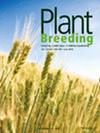桉树(Eucalyptus spp.)
IF 1.8
4区 农林科学
Q2 AGRONOMY
引用次数: 0
摘要
这项研究探讨了在经处理木材的育种计划中对原木末端劈裂的重要考虑。针对这一特殊性状的表型过程的有效优化研究还很少。该研究旨在比较原木端部劈裂表型的方法,并开发一种基于图像的裂纹评估方法。最初,使用人工测量、数字图像分析和目测评估对 32 个桉树克隆进行了表型分析。结果显示了相似的表型值,但图像分析显示了更好的克隆分辨能力,与人工测量相比,评估时间缩短至 78 小时。第二部分的重点是使用真实和合成图像测试卷积神经网络架构(UNet、LinkNet 和 FPN)。基于更高的交集大于联合(IoU)值,U-Net 略胜一筹,与真实值的相关性高达(.89)。这种方法大大缩短了评估时间,约为 10.15 小时,与传统方法相比效率更高。本文章由计算机程序翻译,如有差异,请以英文原文为准。
Phenotyping methodologies of log end splitting in eucalyptus (Eucalyptus spp.)
This study addresses the crucial consideration of log end splitting in breeding programmes for treated wood. There is a paucity of research focused on efficiently optimizing the phenotyping process for this particular trait. The study aimed to compare methodologies for log end splitting phenotyping and develop an image‐based crack evaluation approach. Initially, 32 eucalyptus clones underwent phenotyping using manual measurement, digital image analysis and visual evaluation. Results showed similar phenotypic values, but image analysis demonstrated better clone discrimination, reducing evaluation time to 78 h compared to manual measurement. The second part focused on testing convolutional neural network architectures (UNet, LinkNet and FPN) using real and synthetic images. U‐Net exhibited slight superiority based on higher Intersection over Union (IoU) values, exhibiting a high correlation (.89) with true values. This approach significantly reduced evaluation time to approximately 10.15 h, emphasizing its efficiency compared to traditional methods.
求助全文
通过发布文献求助,成功后即可免费获取论文全文。
去求助
来源期刊

Plant Breeding
农林科学-农艺学
CiteScore
4.40
自引率
5.00%
发文量
74
审稿时长
3.0 months
期刊介绍:
PLANT BREEDING publishes full-length original manuscripts and review articles on all aspects of plant improvement, breeding methodologies, and genetics to include qualitative and quantitative inheritance and genomics of major crop species. PLANT BREEDING provides readers with cutting-edge information on use of molecular techniques and genomics as they relate to improving gain from selection. Since its subject matter embraces all aspects of crop improvement, its content is sought after by both industry and academia. Fields of interest: Genetics of cultivated plants as well as research in practical plant breeding.
 求助内容:
求助内容: 应助结果提醒方式:
应助结果提醒方式:


